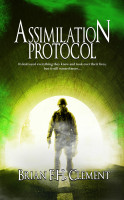Severance by Ling Ma
Farrar, Straus, and Giroux, 2018
ISBN-13: 978-0374261597
Available: Hardcover, Kindle edition, audiobook
Severance starts out fast and almost funny, with the author’s description of a group of survivors Googling YouTube videos on survival skills, because of course they are. It’s 2011, and the End is here. The world has been felled by Shenzhen fever, which is a fungal infection with symptoms that initially mimic the common cold, transported worldwide from factories in China that pay their workers almost nothing and force them to work under unhealthy conditions to produce cheap consumer goods. As the infection progresses, victims find themselves trapped in repeating the same familiar motions, such as setting and clearing the table, over and over, even after their minds are gone.
Candace Chen, a millennial first-generation Chinese immigrant who is now a naturalized American citizen, loves New York City and survives there by working for a publishing company that contracts out its work to the Chinese factories in Shenzhen. Specifically, it’s her job to get Bibles published there. Ma’s demonstration of the hypocrisy involved on the part of companies profiting off Christianity demanding custom Bibles published cheaply, and Candace’s active role in it (she is not a likable character, although she does have some relatable moments) despite the harm done to Chinese workers, is about as subtle as an anvil hitting the reader on the head. She writes lightly, though, and it often reads as satirical rather than serious.
When Candace considers quitting, she realizes she can’t escape complicity as long as she participates in a consumer economy where too many people are ready to buy cheaply made goods, and she loves the city too much to leave. As people flee the city to escape Shenzhen Fever, or at least spend their limited lifespans with family, Candace stays put. Soon she is the only employee left at her company, kept there only by the financial incentive of a large bonus if she continues going in until a certain date, and with only her camera to keep her company as she documents the deserted city for her blog, determined to stay to the bitter end. There isn’t a lot of action in this part, so you might think this would get boring, but it just continues to build the tension.
When she does leave, she runs into a small band of survivors in an otherwise empty world, led by a power-hungry IT guy whose brutality has been freed by the end of civilization, who frequently stops the group to break into houses and steal the belongings of the dead (or sometimes the infected, mindless, living) on their way to a “safe place” he knows of, which turns out to be a shopping mall in a Chicago suburb. If you are starting to get a Romero vibe, I will tell you there are monsters in the shopping mall, but the horror is not what you think it’s going to be. Once again, we get a long, slow build broken by sharp, fast moments of violence.
This is not as straightforward a story as I have described here. The plot threads are entangled, as we learn about the effects of Candace’s story of immigration and family, both in China and the United States; her attempts to fit in with her peers and build romantic relationships; her general feeling of randomness as a twentysomething in New York City; the comfort of working in a job you are good at but don’t necessarily like; and her grasping at survival by any means necessary once that privilege is no longer available. It’s not really possible for me to explain how these come together to make her story, a disturbing and yet one which has many elements to it that should make the reader personally uncomfortable. Beyond her own story, once you read the description of the fungal infection that ends everything, Shenzhen Fever, you’ll find yourself holding your breath. Funny and full of dread, satirical and serious, and somehow pre-apocalyptic, apocalyptic, and post-apocalytic all in the same book, Severance definitely isn’t for everyone, but readers willing to slow down occasionally will enjoy the subtle humor, feel the growing dread and desperation, and find there’s a lot for their minds to chew on.







Follow Us!